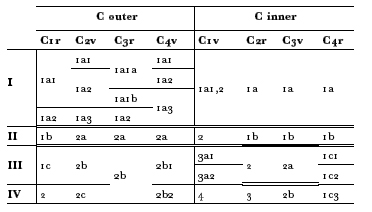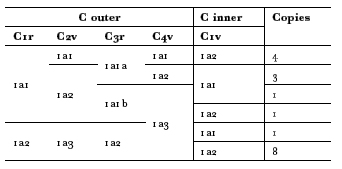| JAMES SHIRLEY'S TRIUMPH OF PEACE:
ANALYZING GREG'S NIGHTMARE
by
STEPHEN TABOR
| ||
§7. Quire C
Table 21 shows four relatively clear-cut phases of production for all of quire
C.
Phases II and III are signalled by reimpositions or resettings that run
straight
across both formes. Phase IV is more subtle, having only two pages
reimposed.
But the remaining pages (except for C3r, which comes over completely
unchanged
from Phase III) all show revisions, some of them major, at the inception

 |
we have already shown initiating the final printing phase of the preceding quires.
(Appendix 3 shows this correlation most clearly.) Phase IV of this quire is found
only with the "third impression" title pages and vice versa. So, despite the lack of
extensive resetting at this point, we can still assert
the likelihood that the alterations to both formes preceding this final phase took place during a significant
pause in the press run.
On C2v, the action of the masque enters its final phase, which features
numerous
songs set in italic. These provide the main source for the italic
raids
discussed in §3.
The production of the quire went as follows:
A. PHASE I
C outer forme shows a normal pattern of variants whose sequence is all
but
certain. The inner forme, however, presents an insoluble problem in the
sorting
of the two variants of C1v, which at line 23 has either (1a1) "We
change
the Seene" or (1a2) "We change the Scene". These are found in the
combinations
shown in table 22. (The remaining three pages of C(i) are invariant,
so
are not shown.) About half the sheets (the eight copies shown in the last row
of
the table) have the latest states of both the outer and inner formes, as we
would
expect, but the other ten sort illogically. Unlike the retrograde pattern of
quire
B Phase I (§6A), the existence of all these permutations cannot be
explained
by any plausible irregularity in turning the stack. Only dropping some
portion
of the sheets on the floor and picking them up more or less at random
would
cause the first state of the inner forme to be printed on the back of three
of the
four variants of the outer forme. "Accidents at the press" is the last
resort of the
baffled bibliographer, and I will not waste space here in trying to
develop such an
explanation.

 |
On C4V the bottom lines of text are bent upwards at the right. The
greatest
amount of deflection is a bit more than 2 mm—so, rather less than half
the
height of one line—but bad register with the text on the back of the leaf
makes
it quite noticeable. This much distortion would be impossible if the
non-printing
space on the page were packed solid; there must have been a gap in
the lockup,
and I would guess that one of the lines of Song 5 somehow got into the
forme
without being justified. Such an oversight would also explain the slight
misalignment
in lines 7–9 on the same page. This precarious situation might have
made
it impossible for a workman to pick up and transport the locked-up forme
in
the manner described by Moxon,
27
but the interaction of pressures along both
dimensions of the
page was apparently sufficient to keep types from being pulled
during presswork.
This is the most graphic demonstration in ToP that
printing
could proceed with adequate stability even if regions of the forme lacked
support
on all four sides. We have already seen instances in §6B of wandering
alignment
between adjacent lines that probably arose from similar causes.
27a
B. PHASE II
Phase II shows raiding of italic on pages C2v, C3r, and C4v. These pages
contained
all of the main caches of italic in the outer forme. C4v was
particularly
heavy-hit, being totally reset except for the roman lines 7–9 and the
last line. After
the raid, the italic Song 5 and its roman title on that page
reappeared in pica size.
The inner forme of quire C offered an even richer source of italic than
the
outer, but it was never raided at this point, or ever during the history of
ToP.
The reason is probably that C(i) was on the press
and inaccessible while C(o) was
being raided. C1v does show resetting of the
italic in lines 8–10 and 25–27, but
this page was not a plentiful source for the
font, and the resettings could have
arisen from some other cause. (For instance,
the earlier state showed a comma

repositioning it.)
C1r in this phase shows some horizontal instability in the
page-number
position.
C. PHASE III
In this phase, pp. C2r and C3v—which lie side by side in the forme—undergo
the
only complete resettings in the history of quire C. Head to head with
these, but
later in the phase, C1v and C4r both show page-number shifts. These
are probably
simultaneous but random drifts, as the types in the page numbers
appear to be the
same before and after. However, the five copies which show this
deviation happen
to be the same ones which contain quire B from Phase IIIb. I
will discuss this
uncomfortable coincidence in §13.
Also in this phase, the text of C1v shows further instability around the
same
points which changed in Phase II: the italic in lines 1 –10 and the last four
lines
is reset, the fourth line up ("A Landschape the
Scene.") going missing in the first of
two steps to a smooth transition
between antimasques. When lines 8–10 were
changed in the previous phase, the
period after "carryed off" in line 9 ended up
below the line (which shows another
unstable lockup). In Phase III, it is properly
aligned, and the resetting of the
nearby italic may have had some connection
with that repair-work.
D. PHASE IV
Phase IV, as mentioned above, is found only in "third impression" copies of
ToP, and, like the final phase of quire A, it introduces
important textual revisions
that alter the page breaks within the quire. Edits on
C1v and 2r shorten the word
count significantly, causing two-line chunks of the
text to move backwards until
the original breaks resume at the end of C2v.
This phase gives us further examples of text that is reset either larger
or
smaller than the prevailing 96 mm "english" size:
C1r: At the top of the page, a brace separates the list of three characters
from
their stage directions on the right. In the original setting, the directions
crowd
right up to the brace. In Phase IV, the direction is reset in 82 mm pica;
the line
breaks are the same, but the page gains some needed white space.
C2r: The antimasque of the "phantastique Adventurer" has the same layout
as the
previous example, with a brace separating the names of the characters
from their
stage directions. In this last phase, the directions are rewritten and
lengthened,
so the compositor reset them in pica type apparently to maintain
visual
balance.
| JAMES SHIRLEY'S TRIUMPH OF PEACE:
ANALYZING GREG'S NIGHTMARE
by
STEPHEN TABOR
| ||